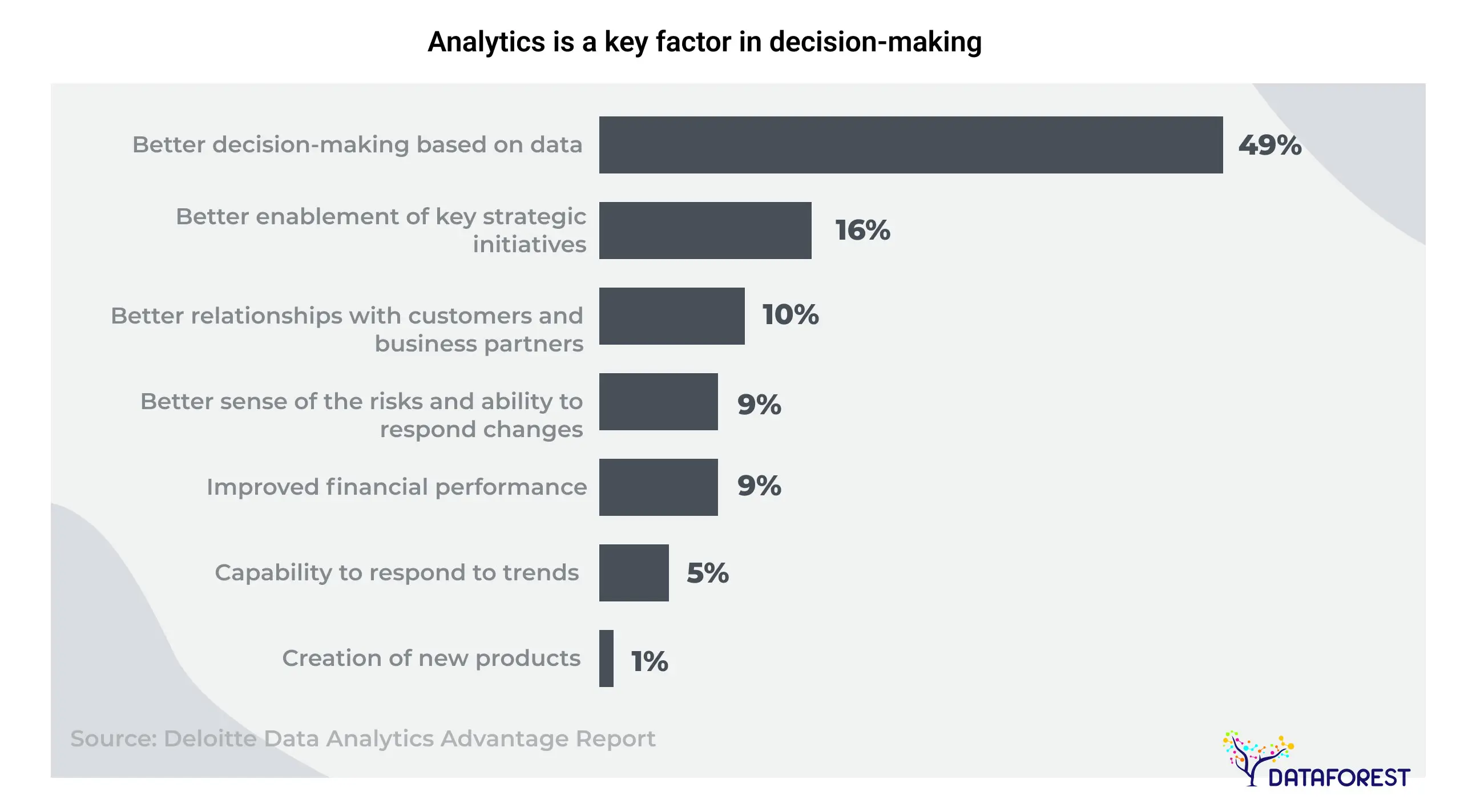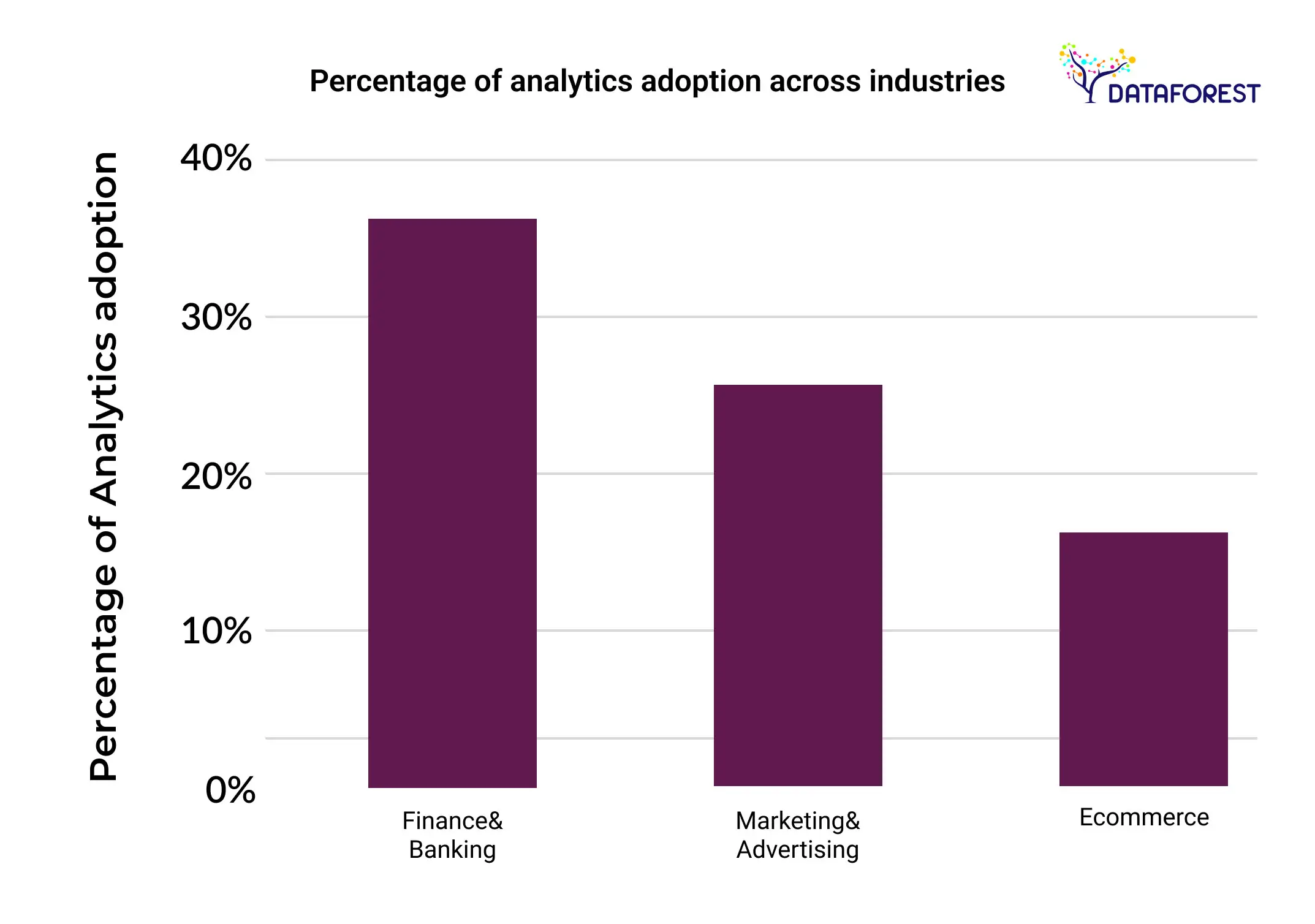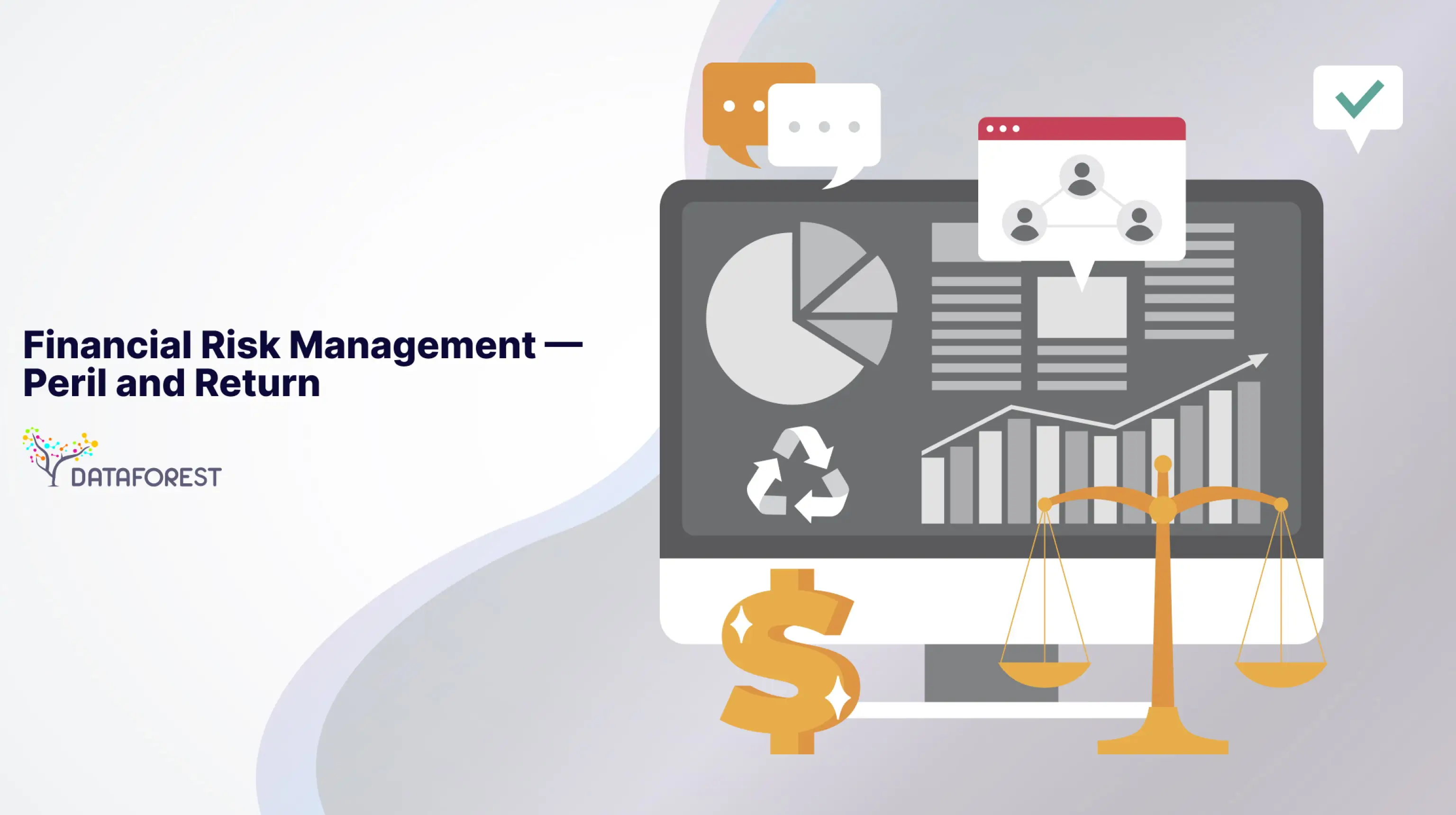Imagine the traditional credit assessment as a dusty library and JPMorgan's machine learning algorithms as a team of speed-reading experts. These algorithms don't just read; they devour massive datasets, scanning through financial histories with the efficiency of a well-oiled engine. The transformation is palpable, moving from the era of one-size-fits-all credit evaluations to a personalized approach that considers nuanced borrower profiles. We can consider your case, just schedule a call.

A Strategic Advantage in Finance
Data science in finance is the key player in transforming raw data into actionable insights.
By decoding complex patterns, predicting market trends, and optimizing decision-making processes, data science for finance becomes the linchpin that sets businesses apart from the pack. It's the secret weapon that turns data into a strategic advantage, giving financial institutions the upper hand in a relentless market.
- The rise of robo-advisors like Wealthfront and Betterment showcases data science in action. These digital financial advisors analyze user financial profiles to tailor investment strategies. By leveraging data science in finance, they offer personalized advice, optimize portfolios, and democratize financial planning.
- Coinbase uses data science as a shield against fraudulent activities in the volatile world of cryptocurrencies. Their algorithms detect anomalies, ensuring the security of digital transactions. This application is about building trust in a digital frontier.
- Renaissance Technologies, a hedge fund pioneer, exemplifies the triumph of data science in finance. Their quantitative approach, fueled by sophisticated algorithms, has consistently outperformed traditional strategies. It's a testament to how data-driven insights can translate into substantial financial gains.
Navigating Tomorrow with Predictive Analytics
Predictive analytics in forecasting is a savvy financial advisor who can see a few moves ahead in the chess game of economics for overall data science and finance results.
- Predictive analytics uses historical data, mathematical algorithms, and statistical models to forecast future financial trends.
- Imagine an intelligent robot that sifts through mountains of financial data, from stock prices to economic indicators. Predictive analytics is its brainpower on steroids.
- Understanding past behaviors and trends guides financiers to make strategic decisions today that could become golden opportunities tomorrow with data science in finance.
- Predictive analytics is the ghostbuster, spotting potential risks before they haunt your portfolio. It's not foolproof, but it's a darn good radar system.
- Data science in finance is more like a reliable weather forecast; it gives you a good idea, but you might still need a backup plan for unexpected storms.

Data Science in Finance with Data-driven Insights
Let's break down risk management with the cool factor of data-driven insights.
- Risk management begins with a data safari, where you're not hunting lions but patterns in the financial wilderness. Data-driven insights are the binoculars that let you spot potential risks lurking in the bushes.
- By analyzing historical data, predictive analytics forecast potential pitfalls before they become financial hurricanes. It's a weatherman for data science in finance, giving you a heads-up on whether to grab an umbrella or batten down the hatches.
- Data-driven risk management isn't just about predicting; it's about scenario planning. It's playing chess with the market, thinking several moves ahead. You can strategize for risks and devise contingency plans by simulating different scenarios.
- Whether monitoring market fluctuations, tracking customer behaviors, or staying alert to global economic shifts, it's about staying vigilant. When financial terrain changes faster than a TikTok trend, real-time insights are your trusty lookout post.
- Risk management through data-driven insights is an ever-evolving dance. It's not a one-and-done deal but a continuous learning process with data science in finance. As the market goes through changes, your data-driven insights adapt.
Tailored Data Science in Finance — Crafting Solutions
Financial products aren't one-size-fits-all; they're tailored suits stitched with the precision of big data.
We know how to handle Big Data; arrange a call and you will know too.

Asset Management with Machine Learning
Machine learning, a subset of artificial intelligence, employs statistical techniques to enable systems to learn and improve from data science in finance without explicit programming.
Data-Driven Decision Making
Machine learning isn't some math wizard in a secret chamber; it's more like your financial coach, who studies your every move to design a workout tailored just for you. With data science in finance, it's sifting through heaps of data, spending patterns, market vibes, and economic whispers to sculpt a strategy that's as unique as your fingerprint.
Predictive Analytics
Machine learning is the weather forecaster telling you if you need an umbrella or sunglasses tomorrow. Analyzing past data predicts market shifts and asset pirouettes, helping you stay one step ahead using data science in finance.
Dynamic Portfolio Management
Think of your investment portfolio as a playlist on shuffle. Machine learning ensures it's not stuck on repeat; it's more like a DJ at a party, adjusting the beats to keep the crowd grooving. It's a living, breathing Instagram story of your data science in finance.
Risk Management
That's like having a financial bodyguard. Machine learning studies the patterns of risks, knows when they might pop up, and guards your assets like a bouncer at an exclusive club. It's about navigating risks like a boss with data science in finance.

Personalized Investment Strategies
Machine learning is like a tailor crafting a suit that fits you perfectly. Your risk appetite, investment goals, and financial dreams are the threads, and within data science in finance, machine learning stitches them into a strategy that's so "you."
Transforming Finance Through Scientific Insight
Data science in finance takes the spotlight as the catalyst for innovation.
Raising Financial Products and Services
Data science in finance orchestrates a financial ballet where insights from the vast data universe back every move. From personalized investment strategies to predictive risk analysis, data science is the backstage maestro crafting a showstopping performance.
- Mining the Gold in Data: Data science in finance digs deep into the treasure troves of information, extracting nuggets of wisdom that fuel the creation of innovative financial products.
- Personalized Financial Symphony: Your financial profile isn't a generic template; it's a unique composition. Data science conducts a personalized financial symphony that considers your risk appetite, spending patterns, and aspirations.
- Risk Mitigation Magic: Financial data science in finance isn't afraid to play the wizard, analyzing historical data and market trends to foresee potential pitfalls. It's the shield that guards against financial storms, ensuring a smoother sail through economic seas.
Disrupting Tradition — The Data Tsunami
If traditional financial models were sturdy ships navigating calm waters, data science is the tsunami shaking the foundations.
- Real-Time Market Insights: Traditional financial models rely on historical data, but finance data science brings real-time insights. It's different between reading yesterday's newspaper and having a live feed.
- The Demise of One-Size-Fits-All: Traditional models often treated everyone like they wore the same financial shoe size. Data science introduces a paradigm shift. It acknowledges the diversity in financial preferences and tailors solutions accordingly.
- Automating the Mundane: Mundane tasks that once required hours of manual effort are now executed at the speed of algorithms. The efficiency booster disrupts the traditional notion of slow-paced processes in data science in finance.
Buckle up because data science's unstoppable force fuels the ride from traditional to transformative.

Blockchain and Data Science
In the grand orchestra of technological innovation, the fusion of blockchain and data science in finance emerges as a duet, each note complementing the other.
Security
Blockchain's decentralized nature and cryptographic algorithms provide an impenetrable fortress for data. Now, cue in data science in finance as the vigilant sentry, analyzing patterns and anomalies within the blockchain. It acts like a detective, fortifying the security protocols. The result? A security arrangement so robust, it's like a digital Fort Knox.
Transparency
The distributed ledger, accessible to all participants, becomes a shared journal of truth. Yet, data science in finance transforms this transparency into actionable insights. It's like having a skilled interpreter amid a multilingual crowd, extracting meaningful information from the plethora of data within the blockchain.
Efficiency
Algorithms analyze transaction histories, identifying bottlenecks and optimizing the flow. Predictive analytics within data science in finance forecasts transaction trends, enabling blockchain to adapt its choreography in real time. Transactional efficiency is so smooth, as a result, it's like a tango between bytes and blocks.
Synergy
Predictive modeling within data science in finance foresees potential security threats, prompting blockchain to tighten its defenses. The transparency in blockchain is elevated by data science's ability to decipher complex data structures, offering more profound insights. And when it comes to transaction efficiency, data science fine-tunes the orchestration.
Implications
Security breaches become a rarity as the combined forces of blockchain and data science in finance create an impenetrable shield. Transparency transcends its surface-level definition, evolving into a tool for informed decision-making. Transaction efficiency reaches new heights, transforming sluggish processes into a nimble dance.
FinOps: The Dynamic Duo of AI and Automation
In financial operations, a technological marvel unfolds — the seamless integration of Artificial Intelligence (AI) and automation with data science in finance.
Operational Efficiency
For data science in finance, AI transforms routine financial tasks into a well-choreographed ballet. Automation, its loyal sidekick, executes these tasks with precision. From invoice processing to reconciliation, the duo works tirelessly, ensuring that operational workflows resemble a finely tuned engine rather than a chaotic traffic jam.
Cost-Cutting
AI's ability to analyze vast datasets identifies cost-saving opportunities in data science in finance, while automation, the trusty squire, executes these optimizations. Together, they're a cost-cutting dream team, slashing operational expenses and ensuring financial operations run efficiently like a well-oiled machine.
Error Elimination
Errors in financial operations are like hidden villains waiting to disrupt the peace. AI's pattern recognition and anomaly detection skills identify potential errors before they rear their ugly heads. Armed with its tools, automation ensures that data science in finance executes every transaction and calculation flawlessly.
Decision-Making
AI is a decision-making dynamo. Its algorithms analyze historical data, market trends, and financial patterns, providing valuable insights. Automation, ever the efficient executor of data science in finance, translates these insights into actionable tasks. Together, they aid in strategic planning and ensure financial operations align with broader organizational goals.
Adaptive Learning
The beauty of AI and automation lies in their ability to learn and adapt. AI algorithms evolve, fine-tuning themselves based on past experiences and outcomes. Automation, the dutiful apprentice, follows suit. This adaptive learning in data science in finance ensures that financial operations aren't static but evolve with the ever-changing financial landscape.
Data Science Challenges in Finance: A Blueprint for Solutions
Here's a simplified spreadsheet outlining data science in finance solutions' challenges in finance.
Charting the Future: Data Science in Finance and Providers
The future of finance is intricately intertwined with data science and its visionary providers, such as DATAFOREST. As financial institutions embrace cutting-edge analytics and machine learning algorithms, they unlock unprecedented insights into customer behavior, risk patterns, and market trends. Data science in finance heralds an era where personalized financial solutions become the norm. Providers are the architects of innovation, sculpting the financial landscape with predictive modeling and real-time decision-making capabilities. The synergy between finance and data science promises a future where agility, efficiency, and data-driven strategies redefine the very fabric of the financial ecosystem.
Please fill out the form so we can start the practical part.
FAQ
Can data science predict financial markets?
While data science in finance can analyze historical data, identify patterns, and generate predictive models, predicting financial markets with absolute certainty remains challenging due to market behavior's inherent complexity and dynamic nature. While data science can offer valuable insights and inform decision-making, predicting market movements is subject to various unpredictable factors and uncertainties.
What are the risks of implementing data science in finance?
The risks of implementing data science in finance include potential inaccuracies in predictive models, significantly when historical patterns deviate due to unforeseen events, and the risk of relying too heavily on algorithms, which may lack the nuance and adaptability of human decision-making, leading to unintended consequences or systematic errors in financial operations. Data privacy and security concerns pose inherent risks, as the vast amount of sensitive financial data becomes a target for cyber threats and regulatory scrutiny.
How does data science contribute to financial compliance and fraud detection?
Data science in finance contributes to financial compliance by automating the analysis of vast datasets to ensure adherence to regulatory standards and quickly identifying and rectifying discrepancies. In fraud detection, data science in finance employs machine learning algorithms to recognize anomalous transaction patterns, enabling real-time identification of suspicious activities and bolstering security measures in the financial landscape.
What is the ROI of investing in data science for financial businesses?
The ROI of investing in data science for financial businesses lies in improved decision-making, enhanced operational efficiency, and the ability to tailor products and services to individual customer needs, leading to increased customer satisfaction and loyalty. Data-driven insights enable better risk management, fraud detection, and cost optimization, contributing to long-term financial resilience and competitiveness in the market.
How can small businesses benefit from data science compared to larger corporations?
Small businesses can leverage data science in finance to gain actionable insights from their limited datasets, enabling more targeted marketing strategies, personalized customer experiences, and efficient operational optimizations. Unlike giant corporations, small businesses can often adapt more swiftly to the insights gained from data science, fostering agility and responsiveness in their decision-making processes.
What first steps should a company take to integrate data science into their financial practices?
The first steps for a company to integrate data science in finance into their financial practices involve defining clear objectives, identifying specific use cases, and building a robust data infrastructure supporting analytical demands. Simultaneously, fostering a data-centric culture and ensuring cross-functional collaboration between data scientists and business experts are essential for a seamless integration that aligns with the company's broader financial goals.
How does data science impact financial services and customer relationships?
Data science in finance transforms financial services by enabling personalized offerings, risk assessment, and fraud detection, leading to enhanced operational efficiency and customer satisfaction. It fosters stronger customer relationships by tailoring financial products, predicting individual needs, and providing real-time insights, creating a more engaging and customer-centric experience in the financial landscape.
Can data science in finance help with sustainability and ethical investing?
Data science in finance can contribute to sustainability and ethical investing by analyzing vast datasets to identify environmentally and socially responsible investment opportunities, aligning portfolios with ethical principles, and promoting sustainable financial practices. This analytical approach enables investors to make informed decisions that yield financial returns and align with their ethical and environmental values, fostering a more sustainable and socially responsible investment landscape.
How does data science help in banking?
Data science in finance can benefit banking by providing advanced analytics and insights, enabling better decision-making, risk management, and fraud detection. It also facilitates personalized customer experiences, improves operational efficiency, and assists in complying with regulatory requirements by analyzing vast datasets. Additionally, data science in finance can optimize processes like credit scoring, enhancing the overall effectiveness and competitiveness of banking services in a rapidly evolving financial landscape.








.svg)















